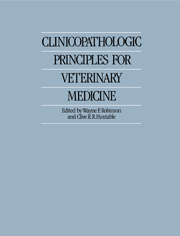Book contents
- Frontmatter
- Contents
- Contributors
- Preface
- Acknowledgements
- 1 The relationship between pathology and medicine
- 2 The immune system
- 3 The hematopoietic system
- 4 Acid–base balance
- 5 The respiratory system
- 6 The cardiovascular system
- 7 The alimentary tract
- 8 The liver and exocrine pancreas
- 9 The urinary system
- 10 The endocrine glands
- 11 The skin
- 12 The skeletal system
- 13 The nervous system
- 14 Muscle
- 15 Metabolic disease
- 16 The reproductive system
- Index
7 - The alimentary tract
Published online by Cambridge University Press: 19 January 2010
- Frontmatter
- Contents
- Contributors
- Preface
- Acknowledgements
- 1 The relationship between pathology and medicine
- 2 The immune system
- 3 The hematopoietic system
- 4 Acid–base balance
- 5 The respiratory system
- 6 The cardiovascular system
- 7 The alimentary tract
- 8 The liver and exocrine pancreas
- 9 The urinary system
- 10 The endocrine glands
- 11 The skin
- 12 The skeletal system
- 13 The nervous system
- 14 Muscle
- 15 Metabolic disease
- 16 The reproductive system
- Index
Summary
Compared with the other organ systems of the domestic animals, the alimentary system is remarkable for its degree of diversity between the species. Despite marked differences in diet, anatomy and digestion, the alimentary tract of each species manages to extract from the material ingested the basic nutrients necessary for maintenance, growth, work, pregnancy and lactation. The alimentary tract also eliminates the indigestible dietary components as well as some of the animal's waste by-products. Again, there is a remarkable diversity in the shape and consistency of this final product.
The volume of information concerning the normal and diseased alimentary system of the domestic species is increasing daily. An in-depth coverage of all this information is obviously beyond the scope of this chapter and beyond the level necessary for preclinical veterinary students. Although it was considered necessary to pay particular attention to some specific species problems such as dysfunction of the ruminant stomachs, an overall attempt has been made to present the general principles of alimentary pathophysiology.
The alimentary tract is usually separated, for the sake of discussion, into upper and lower sections, the upper tract comprising the mouth and esophagus and the lower tract comprising the stomach and small and large intestine. Discussion in this chapter will be directed primarily toward dysfunction of the lower tract. Whilst there are numerous diseases of the upper tract that are of great importance, such as the vesicular diseases, most are species specific and are adequately covered elsewhere.
- Type
- Chapter
- Information
- Clinicopathologic Principles for Veterinary Medicine , pp. 163 - 193Publisher: Cambridge University PressPrint publication year: 1988



